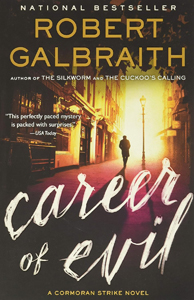In her acknowledgements, J.K. Rowling says “Career of Evil” (2015) was one of her most fun books to write. But ironically, it is her grimmest up to this point. In her third Robert Galbraith novel, she takes a page from Agatha Christie’s “Cards on the Table” and presents only a handful of suspects for the contemporary Jack the Ripper-style killings that have hit London. Yet the small suspect pool doesn’t make the case easier to solve.
Not merely killing women, the murderer hacks off pieces of them as trophies. In one case, the killer sends a leg to Cormoran Strike, thus kicking off the case (no pun intended, but I’ll keep the pun anyway). Rowling literally goes into dark alleys of London, and figuratively into the dark mind of the killer in third-person omniscient chapters. He tells of his annoyance of living with a woman he calls “It,” and how he feels like a god when he gets away with a murder.
Three men from Strike’s past could be the killer – and we’re also invited to keep in mind that it could be someone else. (But I always felt like the killer would at least be connected to one of these three.) Strike and his assistant Robin spend a lot of time surveilling these disgusting men – one a pedophile, one a rapist, one a domestic abuser — making “Career of Evil” the slowest-burn procedural of the first three Strike novels.

“Career of Evil” (2015)
Author: J.K. Rowling, writing as Robert Galbraith
Series: Cormoran Strike No. 3
Genre: Mystery
Setting: England, 2011
Though far from perfect, and lacking the bottom part of one leg, Strike can handle himself. But this case is an emotional and literal danger for Robin, who learns new detective skills but also gets in over her head. She’s dragged in by an emotional attachment to undocumented victims of these suspects and risks overplaying her hand.
Rowling achieves a delicate balance, as we know we’re spending two-thirds of our reading time on suspects who will not turn out to be the serial killer. However, they’ve all done horrible things, and are menaces to society in those ways, and the author achieves an appropriately skeevy backdrop for the serial killings to take place against.
Commentary overshadows the case
“Career of Evil” does function as a whodunit – and Rowling puts a big clue right in my face, but I admit I missed it. However, it’s even more of a story about crime and the detectives’ – especially Robin’s – desire to get dangerous people off the streets. It’s not an easy game to play, as Strike and Robin must consider the strictures of the law, the egos of the Met (the London police force), media perception and their own emotional proclivities.
Although one trip to an isolated coastal town does provide a breather from grimy London, Strike and Robin are in dark personal places. Strike is in a dead-end relationship with Elin, who is beautiful but a boring conversationalist. Robin seems to actively dislike Matthew, the man she’s going to marry, when she lets her guard down and admits it to herself.

With the royal wedding backdrop setting “Career of Evil” in 2011 (thus meaning the previous books take place just slightly before that, finally giving us clear dates), the novel continues to develop the Strike-Robin relationship.
They aren’t a romantic match; Rowling will need to do some convincing in future books before I see them that way. But their partnership is fascinating. They can only talk about the case details with each other, naturally. But this closeness – and the road trip to the coastal town — makes them accidentally open up about other things.
“Career of Evil” closes with a strong final act and an outstanding zinger. But unlike the similarly downbeat third “Harry Potter” book, it doesn’t have many balancing moments. I rate it lower than the first two Strike books for that reason, but it’s nonetheless a compelling mystery with two excellent lead characters.
Sleuthing Sunday reviews the works of Agatha Christie, along with other new and old classics of the mystery genre.

